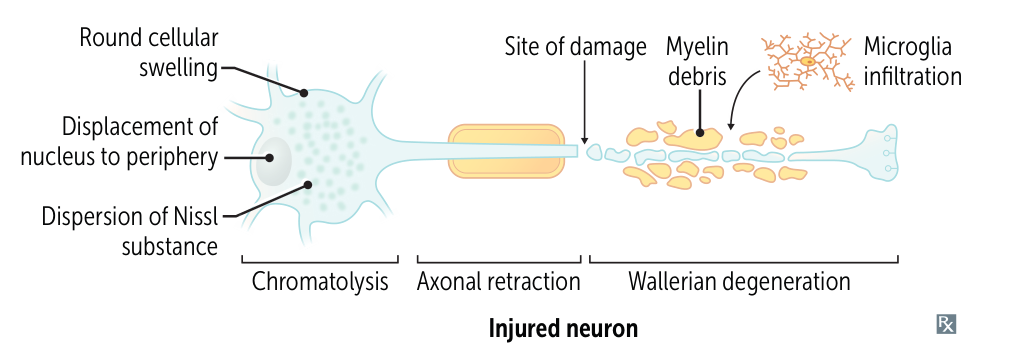The axon is damaged but the perineurium and epineurium remain intact.
Leads to central chromatolysis
- Definition: the reaction of a neuronal cell body in response to an axonal injury
- Function: increase in protein synthesis to help restore the integrity of the damaged axon
- Characteristics
- Swelling of the neuronal body
- Dispersion of the Nissl bodies (which gives the name chromatolysis (chroma: color; lysis: disintegration))
- The rough endoplasmatic reticulum of neurons.
- Displacement of the nucleus to the periphery
Results in Wallerian degeneration
- Definition: an active neuronal degeneration process in response to axonal injury
- Function
- To clear axonal debris and prevent scarring
- Facilitate targeted reinnervation and functional recovery of tissues previously innervated by that axon before injury
- Characteristics

- Initially retained electrical excitability of axonal membrane distal to the injury, lasting up to 36 hours
- Progressive degeneration of distal segment cytoskeleton with dissolution of axonal membrane
- Degradation of residual myelin sheath by macrophages and Schwann cells
- In the central nervous system, phagocytic macrophages/microglia are recruited more slowly because of the blood-brain barrier. This slows removal of the myelin debris, which can persist for years in the degenerating tracts and suppress axonal growth via myelin-associated inhibitory factors.
- The proximal stump either stays in place or retracts slightly
- Ultimately, the cell body will sprout regenerative nerve fibers that, ideally, reinnervate the distal tissues.
- Regeneration is significantly more efficient in the peripheral nervous system than in the central nervous system.
- Good chance of at least partial recovery